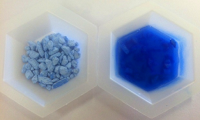By Dr. Christina Wilson, Jonathan Butz, and Mary Mengel

Figure 1. Methomyl bait granules (left) and methomyl granules in water (right)
Methomyl is a broad-spectrum carbamate insecticide sold as a restricted-use, crop insecticide or as a non-crop, “fly bait” insecticide for residential use. Methomyl is available over-the-counter and is sold under the trade names
Starbar Golden Malrin® Fly Bait,
DeoSect™ II Fly Bait, and
Stimukil® Fly Bait. These products are formulated with 1% (10,000 ppm) methomyl and the granules have a characteristic turquoise blue color (see figure 1). These bait formulations are often scattered on the ground or mixed with a liquid (such as soda or other sweet liquid) to attract and kill flies in animal or poultry houses and to control insects on fruits and vegetables. Unfortunately, these products are illegally being promoted to control coyotes, raccoons, and opossums. As a result, accidental ingestion of this insecticide has resulted in acute poisoning in non-target species, such as dogs and cats. Over the past two years, the ADDL has observed an increase in cases of accidental methomyl poisoning in animals. These cases were due to animals unwittingly ingesting the poison when it was being used residentially to control insects near fruit trees or when the product was misused to control nuisance wildlife and rodents.
Methomyl inhibits acetylcholinesterase in nervous tissue causing acetylcholine to accumulate at the muscarinic and nicotinic receptors at neuromuscular junctions, ultimately resulting in overstimulation of the sympathetic and parasympathetic nervous system.1 Onset of clinical signs may occur within 15 minutes to 1 hour post-exposure, depending on the dose. Muscarinic signs can include salivation, lacrimation, urination, defecation, dyspnea, and/or emesis (SLUDDE signs). Miosis and bradycardia may also be observed.2 Nicotinic clinical signs are often associated with seizures, muscle fasciculations, tachycardia, ataxia and/or paralysis in exposed animals.2 Death occurs due to respiratory failure.
Methomyl exposure in animals is diagnosed at the ADDL based on clinical signs/case history and diagnostic testing of biological samples from the animal. Methomyl can be detected in whole blood (submitted in EDTA or heparin), liver, stomach/rumen contents, vomitus, bait, or contaminated water or foodstuffs. Testing acetylcholinesterase activity in brain tissue or whole blood (submitted in EDTA or heparin) can also suggest exposure to methomyl (or other carbamate and organophosphate insecticides). Brain or blood acetylcholinesterase levels less than 25% of normal are considered diagnostic, while levels less than 50% are considered suspicious for exposure.2 Caution must be taken when collecting samples for diagnostic testing as methomyl and other carbamate and organophosphate insecticides can be dermally absorbed.
Differential diagnoses to consider in these cases include other CNS stimulants such as carbamates/organophosphates, metaldehyde, sodium monofluoroacetate, caffeine, antidepressant medications, chocolate, illicit drugs (cocaine, LSD, methamphetamine), lead, nicotine, 4-aminopyridine, strychnine, organochlorine insecticides, pyrethrins/pyrethroids, tremorgenic mycotoxins, zinc phosphide, or systemic diseases.
Prevention is key for limiting exposure to methomyl or other insecticides. Ensure that animals and pets do not have access to the insecticide and make sure pet or livestock owners follow labeled instructions on the proper use of the product. Please feel free to contact the ADDL Toxicology Section if you have a suspect case or need a consult with regard to specimen submission or direction on diagnostic testing.
- Gupta, RC (2012) Organophosphates and Carbamates. In: Veterinary Toxicology: Basic and Clinical Principles. R. Gupta (editor). Elsevier, Inc., San Diego, CA, pp. 573-585.
- Gualtieri, J (2011) Organophosphate and Carbamate Insecticides. In: Blackwell’s Five-Minute Veterinary Consult Clinical Companion Small Animal Toxicology. GD Osweiler, LR Hovda, AG Brutlag, JA Lee (eds). Wiley-Blackwell, Ames, IA, pp. 628-635.